人教新课标高中英语必修二Unit4 Wildlife protection reading 说课课件 .ppt
- 格式:ppt
- 大小:4.24 MB
- 文档页数:27
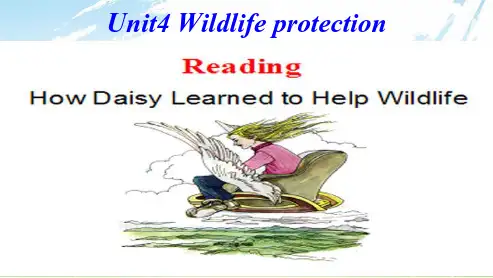
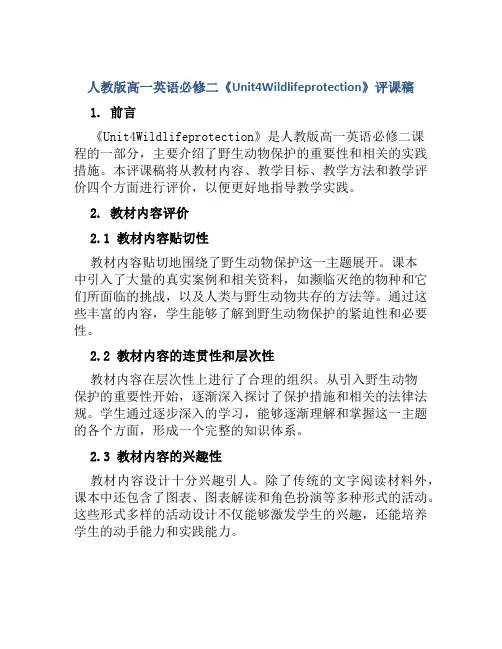
人教版高一英语必修二《Unit4Wildlifeprotection》评课稿1. 前言《Unit4Wildlifeprotection》是人教版高一英语必修二课程的一部分,主要介绍了野生动物保护的重要性和相关的实践措施。
本评课稿将从教材内容、教学目标、教学方法和教学评价四个方面进行评价,以便更好地指导教学实践。
2. 教材内容评价2.1 教材内容贴切性教材内容贴切地围绕了野生动物保护这一主题展开。
课本中引入了大量的真实案例和相关资料,如濒临灭绝的物种和它们所面临的挑战,以及人类与野生动物共存的方法等。
通过这些丰富的内容,学生能够了解到野生动物保护的紧迫性和必要性。
2.2 教材内容的连贯性和层次性教材内容在层次性上进行了合理的组织。
从引入野生动物保护的重要性开始,逐渐深入探讨了保护措施和相关的法律法规。
学生通过逐步深入的学习,能够逐渐理解和掌握这一主题的各个方面,形成一个完整的知识体系。
2.3 教材内容的兴趣性教材内容设计十分兴趣引人。
除了传统的文字阅读材料外,课本中还包含了图表、图表解读和角色扮演等多种形式的活动。
这些形式多样的活动设计不仅能够激发学生的兴趣,还能培养学生的动手能力和实践能力。
3. 教学目标评价3.1 知识目标根据教学大纲的要求,教学目标明确。
通过学习本单元的内容,学生应该能够掌握有关野生动物保护的相关知识,了解保护措施和相关的法律法规。
3.2 能力目标教学目标中强调了培养学生的口头表达能力、独立思考能力和解决问题的能力。
通过课堂上的互动和小组活动,学生能够得到锻炼,并在实践中不断提升这些能力。
3.3 情感目标教学目标中也涵盖了培养学生的环保意识和责任感。
通过学习野生动物保护的案例和相关知识,学生能够更好地理解人类与自然环境的关系,并形成积极的环保态度。
4. 教学方法评价4.1 多媒体教学法多媒体教学法在本单元教学中得到了广泛运用。
通过使用图片、音频和视频等多种媒体形式,能够更直观地展示野生动物保护的案例和实际情况,提高学生的学习兴趣和理解能力。
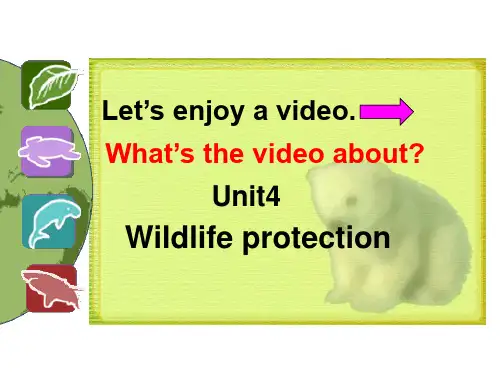
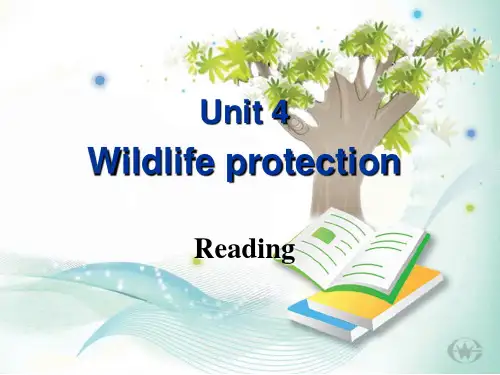
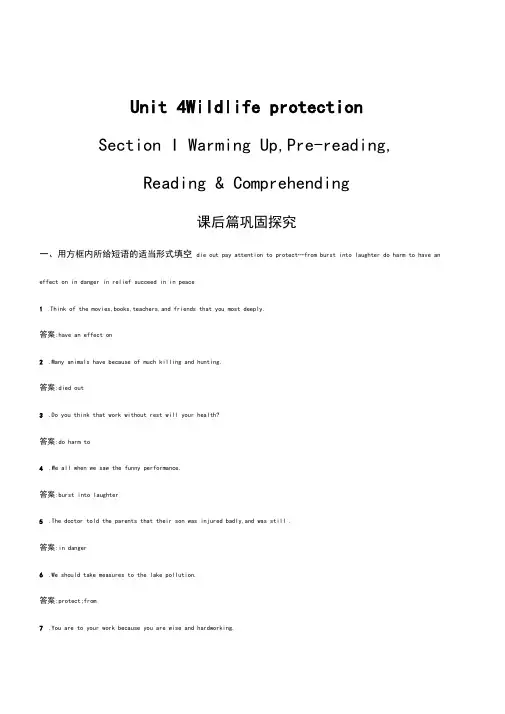
Unit 4Wildlife protectionSection I Warming Up,Pre-reading,Reading & Comprehending课后篇巩固探究一、用方框内所给短语的适当形式填空die out pay attention to protect…from burst into laughter do harm to have an effect on in danger in relief succeed in in peace1.Think of the movies,books,teachers,and friends that you most deeply.答案:have an effect on2.Many animals have because of much killing and hunting.答案:died out3.Do you think that work without rest will your health?答案:do harm to4.We all when we saw the funny performance.答案:burst into laughter5.The doctor told the parents that their son was injured badly,and was still .答案:in danger6.We should take measures to the lake pollution.答案:protect;from7.You are to your work because you are wise and hardworking.答案:succeed in8.People won' t you when they still have a lot of ideas of their own crying forexpression.答案:pay attention to9.Not until we succeed in letting wildlife live in peace,can we smile .答案:in relief10.Don' t bother me;just let me stay here.答案:in peace二、单句语法填空I.Nature deserves our(protect) because we are part of it.答案:protection1.1t never occurred to him that his carelessness could do such great(harm) to himself.答案:harm3.He prefers to live a (peace) life in the countryside.答案:peaceful4.Do you know the task is very (danger)?答案:dangerous5.(2017 江苏)In southern Spain the sudden(increase) of greenhouses (which reflect light back to space) has changed the warming trend locally,and actually cooled the region.答案:increase6.When we heard the joke,all of us burst out (laugh).答案:laughing7.His question failed to get (respond)from his students.答案:response8. — Don' t worry,Mom.The doctor said it was only the flu.—What relief!I ' ll tell Dad there ' s nothing serious.答案:a9.They were(succeed) in achieving both aims.答案:successful10.(2017 江苏)Far from charging consumers high prices,many of these services are free (users pay, effect,by handing over yet more data).答案:in11.(2017 全国出)He posted his offer on a social networking website,and received thousands of emails,(include) thirty from actual Elizabeth Gallaghers with the right passports.答案:including12.The films which (affect)us many years ago still have effect on our children.答案:affected;an13.Great attention must(pay)to developing education,especially in the countryside.答案:be paid14.In order to make money,some farmers often hunted some (endanger) species and killed them without mercy.答案:endangered15.I would greatly appreciate if you would send me the application forms as soon as possible.答案:it三、单句改错1.Finally,I wish this year ' s English speech competition great success.答案:在great前加a1.1 would greatly appreciate if you would give me a hand.答案:在if 前加it3 .We should pay more attention the needs of our elders.答案:在the 前加to4 .They are likely to respond positively for the president ' s request for aid.答案:第一个for 改为to5.In our relief,he was not injured in the car accident.答案:把第一个In 改为To四、课文精彩回顾Daisy had always longed to help 1.species of wildlife.One day she was taken to a 2.land where animals could be found.When Daisy arrived in Zimbabwe,an elephant asked her if she cameto take a photo.Daisy 3.into laughter on hearing its words.The elephant told her that they used to be.At that time the government decided to take measures to protect the wildanimals,which showed the 5.of wildlife protection.When Daisy was in a thick rainforest,amosquitoes,explaining that the millipede insect 8. mosquitoes.He said people should pay more 10.to the rainforest wherehe lived.Only in this way could people live in peace with wildlife.答案:1.endangered 2.distant 3.burst 4.mercy5.importance6.rubbed7.protecting8.contained9.affected 10.attention五、阅读理解hunted without 4. monkey watched them as he 6. himself.He told Daisy that he was 7.himself from a powerful drug which 9.(棣心宣卷思维品质)Have you ever wondered what wild animals do when no one is watching?Scientists have been able to record the private" momentsof wildlife with leading-edge technology.Low-cost,dependable and small modern cameras are a big help.Cameras placed in hard-to-reach places have taken videos of everything from small desert cats to larger snowloving felines(猫科)in the northern Rocky Mountains.These cameras are important tools to learn new information on wildlife.Some videos help scientists see the effects of climate change.For example,the desert animal javelina and the treeloving coatimundi(长鼻浣熊)have been caught on cameras north of their normal home.This could mean global warming is enlarging their living area northward.Researchers use cameras along with global positioning systems,or GPS.They attach GPS devices(设备)to mule deer and antelope (羚羊)in and around Yellowstone National Park.Then they can record their movements,or migrations(迁移).These cameras can be left in very rural(荒里予的)areas for days,weeks or even months.They can provide information on how many animals are moving over a given period of time.Rural video can show details about animal behavior,such as the calls made by migrating mule deer.Also,some cameras record animal life,showing everything from bison in Saskatchewan,Canada,to the underwater weed forest off California ' s Channel Islands.However,rural cameras have their problems too.Animals such as wolverines and bears sometimes attack them.Scientists do not know if the attacks are the results of anger or interest.Also,the devices have become popular tools to help hunters look for animals.Some people argue that it is unfair to use the cameras that way.Even with such problems,rural cameras are clearly an important scientific tool in researching wild animals.1.Which of the following helps scientists know about climate change?A.How active animals are.B.Where animals go.C.What animals eat.D.When animals move.答案:B解析:细节理解题。
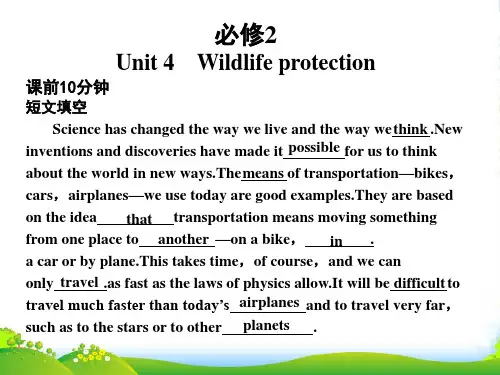
![【教育资料】人教新课标必修二_Unit_4_Wildlife_protection[单元教案]学习精品](https://uimg.taocdn.com/8ffba140a5e9856a57126029.webp)
Unit 4 Wildlife protectionPart One: Teaching Design (第一部分:教学设计)Period 1: A sample lesson plan for reading(HOW DAISY LEARNED TO HELP WILDLIFE)AimsTo talk about endangered speciesTo read about wildlife protectionProceduresI. Warming up by learning about animalsLook at the photos below and listen to me telling you about the animals, the endangered animals.The Giant Panda is a mammal now usually classified in the bearfamily, Ursidae, that is native to central China.The Giant Panda lives in mountainous regions, like Sichuan andTibet. The Giant Panda is the symbol of the World WildlifeFund (WWF), a conservation organization. Toward the latter half of the 20th century, the panda also became somewhat of a national emblem for China, and is now used in Chinese gold coins.Giant Pandas are an endangered species, threatened by continued loss of habitat and by a very low birthrate, both in the wild and in captivity. About 1,600 are believed to survive in the wild.Milu deer is a Chinese deer. It has a long tail, wide hooves, and branched antlers. AnotherChinese name for it is “four unlikes,.”because the animals were seenas having the horns of a stag, the neck of a camel, the foot of a cow, andthe tail of an ass.These animals were first made known to Western science in the 19th century, by Father Arm and David, a French missionary working in China. At the time, the only surviving herd was in a preserve belonging to the Chinese emperor. The last herd of Milu deers that remained in China were eaten by Western and Japanese troops that were present at the time of the Boxer Rebellion.These deer are now found in zoos around the world, and a herd of Milu deer wasreintroduced to Dafeng Reserve, China in the late 1980s. They are classified as “critically endan gered.” in the wild, but do not appear to have suffered from a genetic bottleneck because of small population size.A tiger is a large cat famous for its beautiful fur of orangestriped with black. Tigers live in Asia and are becoming veryrare. This is due to people hunting them for their fur anddestroying the forests they live in.II. Pre-reading1.Defining wildlifeWhat does the world wildlife mean?The term wildlife refers to living organisms that are not in any way artificial or domesticated and which exist in natural habitats. Wildlife can refer to flora (plants) but more commonly refers to fauna (animals). Needless to say, wildlife is a very general term for life in various ecosystems. Deserts, rainforests, plains, and other areas—including the most built-up urban sites—all have distinct forms of wildlife.Humankind has historically tended to separate civilization from wildlife in a number of ways; besides the obvious difference in vocabulary, there are differing expectations in thelegal, social, and moral sense. This has been reason for debate throughout recordedhistory. Religions have often declared certain animals to be sacred, and inmodern times concern for the environment has provoked activists to protestthe exploitation of wildlife for human benefit or entertainment.2.Reading to the recordingNow turn to page 26, listening and reading to the recording of the text. Try to keep pace with the native reader, making your reading resemble that of the reader, in speed, in intonation and in pronunciation.3.Reading and transformingNow you are to read the text for information to fill in the form.4.Reading and underliningNext you are to read the text and underline all the collocations at the same time.III. Closing up by matching animals to five risk categoriesDifferent endangered species appear on different endangered species lists. And people who are trying to protecting animal use the following five risk categories to group the unlucky animal. Now in groups of four try to group all the unlucky animals found in China.Period 2: A sample lesson plan for Learning about Language(The Present Progressive Passive Voice)AimsTo learn about The Present Progressive Passive V oiceTo discover useful words and expressionsTo discover useful structures.ProceduresI. Warming up by acting a text playGood morning class. To begin with we shall put our text HOW DAISY LEARNED TO HELP WILDLIFE on stage, that is, to act out our story. Now the class acting team with their text play of HOW DAISY LEARNED TO HELP WILDLIFE!II. Discovering useful words and expressions1. Doing vocabulary exercisesTurn to page 28 and do the vocabulary exercises 1, 2 and 3. You can simply write your answers in the blanks on the very page of 28.2. Playing a gameLet’s go on to play the game described on the top of the page 29. The following sentences are to be passed on.▲Plant native plants in your backyard.▲Do not dump weeds in the bush.▲Build a frog pond in your backyard.▲Put your rubbish in the bin.▲Leave your pets at home.▲Do not take anything out of the park.▲Encourage your friends to keep patches of bush as wildlife habitats.▲Join a community group and offer to do voluntary work.▲Find out about conservation activities happening in your local area.▲Participate in local clean-up, tree planting and weed control activities.▲Learn About Threatened Species▲Look out for wildlife▲Refuse to buy any rare or endangered plant or animal product.▲Be alert and drive slowly at dawn and dusk in rural areaswhere wildlife may be active.III. Studying The Present progressive Passive Voice1. Passive VoiceThe passive voice is used when focusing on the person or thing affected by an action.The Passive is formed: Passive Subject + To Be + Past ParticipleIt is often used in business and in other areas where the object of the action is more important than those who perform the action. For Example: We have produced over 20 different models in the past two years. Changes to: Over 20 different models have been produced in the past two years.If the agent (the performer of the action) is important, use “by.” For Example:Tim Wilson wrote The Flight to Brunnswick in 1987.The Flight to Brunnswick was written in 1987 by Tim Wilson.Only verbs that take an object can be used in the passive.The following chart includes sentences changed from the active to the passive in the principal tenses.2. Passive Verb FormationThe passive forms of a verb are cr eated by combining a form of the “to be verb.” with the past participle of the main verb. Other helping verbs are also sometimes present: “The measure couldhave been killed in committee.” The passive can be used, also, in various tenses. Let’s take a look at the passive forms of “design.”IV. Reading and identifyingSince you are clear about Passive Verb Formation, go back to page 26 and scan the text for all the examples of The Present Progressive Passive V oice.Now try to put the following sentences into The Present Progressive Passive V oice.▲They are producing this new drug.▲Antelope is looking at her.▲They are killing us for the wool.▲They are destroying the farm.V. Discovering useful structuresTo consolidate your learning of The Present Progressive Passive V oice, turn to page 29 and do the grammar exercises 1, 2 and 3, also on the very page of 29.VI. Closing down by playing a gameTo end this period go to page 29 and play the game called “Tell me what is happening?” Ask questions containing The Present Progressive Passive V oice.Period 3: A sample lesson plan for Using Language(ABOUT DINOSAURS)AimsTo read and listen about dinosaursTo speak about helping the dodoTo write to the dodoProceduresI. Warming up by reading to the tapeLet’s warm up by reading aloud to the recording of the textABOUT DINOSAURS on page 30.II. Listening about DINOSAURSNow I’d like to tel l you something about DINOSAURS■In formation about DinosaurDinosaur means terrible lizard in Latin. They were called that because peopleused to think dinosaurs were lizards, but they were not. Dinosaurs firstappeared about 200 million years ago. 65 million years ago, many kinds ofdinosaurs became extinct. Birds are a special type of dinosaur and they were the only kind to live until today.There were many kinds of dinosaurs. Some ate plants and some atemeat. The largest dinosaurs were plant-eaters like apatosaurus andbrachiosaurus. They were the largest animals to ever walk on dryland.Other plant-eaters had special weapons to help them fight off the meat-eaters. For example, triceratops had three horns on its face, ankylosaurus was covered in boney plates, and stegosaurushad spikes on its tail.The meat-eaters all ran around on their back legs like people do. Some were very large, liketyrannosaurus, and some were small, like compsognathus. It was thesmaller sized meat-eaters that evolved into birds. One of the first birdswas archaeopteryx, but it looked half like a dinosaur.There were large flying reptiles that lived at the same time as dinosaurs called pterosaurs, but they were not closely related to dinosaurs. There were also many kinds of large reptiles that could swim, like ichthyosaurs and pleisiosaurs, but they weren’t closely related to dinosaurs either.III. Reading and copyingNext we shall go back to the text ABOUT DINOSAURS on page 30 again to read it and copy down all the expressions into your notebook.IV. Reading to answer questionsRead the questions in the table below and scan the text to answer them.V. Listening about the dodoHave you ever heard of the dodo, an animal that has also disappeared from the earth?The Mauritius Dodo (Raphus cucullatus, called Didus ineptus byLinnaeus), more commonly just Dodo, was a metre-high flightlessbird of the island of Mauritius. The Dodo, which is now extinct,lived on fruit and nested on the ground.Next we are going to listen to the tape and do exercises 1 and 2 onpage 30 on dodo.VI. Speaking in pairs about helping the dodoZhao Yannan: The Dodo was driven to extinction by sailors when they discovered the island ofMaritius in the 17th century. It is one of the first documented humaninduced extinctions.Zhao Yanfei: What a pity that we can not find any dodo now. Imagine we arewith the dodo, Yannan, what could we do to help it?Zhao Yannan: Then I would intend to hide it in a cave, so that sailors could not find it.Zhao Yanfei: If I were there, I would try to trap them as they were catching and killing the dodo. Putting man who is harmful to the dodo in a cage and attacking him is the best way to protect and save the dodo.Zhao Yannan:I’d like to and I’m ready to, teach man how to be friends with animals, including the dodo. The man and the dodo can be living side by side on the earth. They can be happy together.ZhaoYanfei: I would rather not tell you what I think of man. He is selfish and cruel. He cares only for himself and that is why so many animals have disappeared from this earth. Putting the bad men in a cage is the only way out, I am sure.VII. Closing down by writing to the dodoAll right now, boys and girls, to end this period next you are to write a letter or an email to the dodo telling him what you are going to do to save him.Part Two: Teaching Resources (第二部分:教学资源)Section 1: A text structure analysis of HOW DAISY LEARNED TO HELP WILDLIFE I. Type of writing and summary of the ideaII. A text play (课本剧)of HOW DAISY LEARNED TO HELP WILDLIFEDaisy: (waking) Who are you? Why are you here in my bedroom?Chair: Excuse me. I am the famous Flying Chair.Daisy: What are you here for?Chair: I am here to take you on a trip. Where would you go?Daisy: I’d like to see animals that gave furs to make this sweater of mine.Chair: During the history of the earth there have lived on the earth many, many kinds of animals. But many have disappeared because of various reasons.Daisy: Yes, you are right. I learned from books that tens of millions of years ago, a rare newspecies of dinosaur, a bird-like dinosaur, came into being. It could climb trees and was very lovely. Then it died out because something hit the earth suddenly, putting much dust into the air. So the earth got too hot for the animal to live on.Chair: But no one knows for sure what caused all those ancient animals to die out, disappearing from the earth for ever.Daisy:I shall get dressed and put on my jeans and sweater soon. Then let’s flyaway to Tibet China to see the antelopes.Chair: Here we are in Tibet! T urn around. There is a antelope there with a sadface.Antelope: Hello, friends. Welcome to my home. You two look so friendly, unlike those who cameto kill us to use our furs make sweaters.Daisy: Sweaters like the one I am wearing?Oh, I am terribly sorry.Antelope: The bad men came in groups to kill my family members forthe wool. They took it from under our stomach.Chair: I shall take a picture of you and the antelope, to be shown to all the world people. Daisy:Come Antelope! Let’s have a pic ture taken together. We shall be off to Zimbabwe too see elephants there.Chair: Here we are. This is a national park for animals. People came to see them and help with them.Daisy: Look, there comes an excited elephant. Hello, dear Elephant! Why are you so excited? Elephant: We are all excited because things have changed a lot here.Chair: Why? What happened?Elephant:We became endangered years ago. People came to destroy the farm and kill us for trunks. They are actually our long teeth.Daisy: I have heard of that. They take your teeth and make them into art work.Chair:Man is really selfish and disgusting. But Daisy is a nice girl. Now let’s have a picture taken together.Elephant: Those bad men used to come and kill us. But now are well protected by thegovernment and the good people. We are happy now.Daisy: Good- bye, Elephant!Chair: Take care, Daisy. We shall hurry to our last stop, the thick rain forest in South America. Daisy: Wow! Look to the right. A lovely mother monkey is there. She seems to be rubbing herself. Hi, Monkey Mother! What are you doing?Monkey: I am rubbing a millipede insect over my body to protect myself from the mosquitoes. Daisy: How intelligent you are!Monkey: It contains a powerful drug which affects mosquitoes. There are lots of plants and little animals in the rain forest here which can be helpful to man.Daisy: Is that so? I am going to take photos of all those useful plants and animals. I will show the photos to my classmates so that they understand you lovely animals and the forest better. I will apply to be allowed to work here to help you get a better living in the forest.Monkey: Thank you so much! Some unfriendly people came to catch us, to put us in the zoo in the city. We monkeys prefer living in the forest.Daisy: Good- bye, Monkey! I will report what I learned on this trip to WWF. I will invite all my schoolmates to join us in the protecting project. The future is to be bright for both you the animals and us the human beings. See you!Section 2: Background information on wildlife protectionI. 中国国家重点保护动物名录■国家一级保护动物最凶猛的雕:金雕1.金雕Aquila chrysaetos2.白鹳Ciconia ciconia3.黑麂Muntyacus crinifrons4.云豹Neofelis nebulosa5.华南虎Panthera tigris6.豹Panthera pardusfusca7.白颈长尾雉Syrmaticus ellioti 8.黄腹角雉Tragopan caboti■国家二级保护动物鬣羚:真兽下纲,反刍亚目,有角下目,牛科1.鬣羚Capricornis sumatraensis2.豺Cuon alpinus3.金猫Felis temmincki4.短尾猴Macaca arctoides5.猕猴Macaca mulatta6.穿山甲Manis pentadactyla7.黄喉貂Martes flavigula8.斑羚Naemorhedus goral 9.大灵猫Viverra zibetha10.小灵猫Viverricula indica 11.雀鹰Accipiter nisus12.赤腹鹰Accipiter soloensis 13.苍鹰Accipiter gentilis14.鸳鸯Aix galericulata 15.乌雕Aquila clanga16.白腹山雕Aquila fasciata 17.短耳鸮Asio flammeus18.长耳鸮Asio otus 19.雕鸮Bubo bubo20.灰脸鹰Butastur indicus 21.大鵟Buteo hemilasius22.毛脚鵟Buteo lagopus 23.普通鵟Buteo buteo24.红脚隼Falco vespertinus 25.灰背隼Falco columbarius26.游隼Falco peregrinus 27.燕隼Falco subbuteo28.红隼Falco tinnunculus 29.领鸺鹠Glaucidium brodiei30.斑头鸺鹠Glaucidium cuculoides 31.白鹇Lophura nycthemera32.小隼Mrcrohierax caerulescens 33.鸢Milvus migrans34.鹰鸮Ninox scutulata 35.小杓鹬Numenius borealis36.领角鸮Otus bakkamoena 37.红角鸮Otus scops38.勺鸡Pucrasia macrolopla 39.蛇雕Spilornis cheela40.鹰雕Spizaetus nipalensis 41.褐林鸮Strix leptogrammica42.草鸮Tyto capensis 43.大鲵Andrias davidianus44.虎纹蛙Rana tigrina 45.拉步甲Carabus lafossaeiII. What is WWF?WWF, the global conservation organization was originally known as World Wildlife Fund.In 1986, it changed its name to World Wide Fund For Nature (except inthe US and Canada) to better represent the spread of its work. It wasfounded on September 11, 1961 by, among others, the biologist Sir JulianHuxley, Prince Bernhard of the Netherlands, Max Nicholson and thenaturalist and painter Sir Peter Scott who designed the original black andwhite panda logo. It is one of the world’s largest environmental organizations, with a network ofoffices in nearly 60 countries and a secretariat in Gland, Switzerland.Probably the most famous name associated with WWF is HRH The Duke of Edinburgh. The Dukewas the first President of WWF-UK from its foundation in 1961 to 1982,International President of WWF (1981-2019), and is now PresidentEmeritus.WWF is dedicated to stopping the degradation of the planet’s natural environment and building a future in which humans live in harmony with nature, by: ▲conserving the world’s biological diversity,▲ensuring that the use of renewable natural resources is sustainable,▲promoting the reduction of pollution and wasteful consumption.WWF has a factual, science-based approach to conservation, which focuses on six priority issues of global concern: forests, oceans and coasts, fresh water, endangered species, and the insidious threats of toxic chemicals and climate change. For each of these issues, WWF has developed measurable targets and runs more than 1,200 field projects around the world in any year.III. AntelopeThe antelope are a group of herbivorous African animals of the family Bovidae, distinguished by apair of hollow horns on their heads. These animals are spread relativelyevenly throughout the various subfamilies of Bovidae and many are moreclosely related to cows or goats than each other. There are many differentspecies of antelope, ranging in size from tiny to very big. They typically have a light and elegant figure, slender, graceful limbs, small cloven hoofs, and a short tail. Antelope have powerful hindquarters and when startled they run with a peculiar bounding stride that makes them look as though they are bouncing over the terrain like a giant rabbit. Some species of antelope can reach speeds of 60 miles per hour (100 kilometers per hour), making them among the fastest of land animals.IV. ElephantElephantidae (the elephants) is the only extant family in the order Proboscidea. Elephantidae has three living species: the Savannah Elephant and Forest Elephant (which were collectively known as the African Elephant) and the Asian Elephant (formerly known as the Indian Elephant). During the period of the ice age there were more species, which are now extinct.Elephants are the largest living land mammals. At birth it iscommon for an elephant calf to weigh 100 kg (225 pounds).It takes 20 to 22 months for a baby elephant to mature tobirth, the longest gestation period of any land animal. An elephant may live as long as 60 to 70 years. The largest elephant ever recorded was a male shot in Angola in 1974, weighing 12019 kilograms or 26400 pounds.Prehistoric human beings have been known to eat elephants, as recent findings of animal remains in central China show. The elephant is now a protected animal, and consumption is prohibited around the world.V. MonkeyA monkey is any member of two of the three groupings of simian primates. These two groupings are the New World and Old World monkeys. Because of their similarity to monkeys, apes such as chimpanzees and gibbons are sometimes incorrectly called monkeys. Also, a few monkey species have the word “ape.” in their common name. Because they are not a single coherent group, monkeys do not have any important characteristics that they all share and are not shared with the remaining group of simians, the apes.Monkeys range in size from the Pygmy Marmoset, at 10 cm (4 inch)long (plus tail) and 120 g (4 oz) in weight to the male Mandrill, almost1 metre (3 ft) long and weighing 35 kg (75 lb). Some are arboreal(living in trees), some live on the savanna; some eat fruit, some eatleaves, and some eat insects; although most have tails (sometimesprehensile), others do not; some have trichromatic colour vision likethat of humans, others are dichromats or monochromats. Although both the new and old world monkeys, like the apes, have forward facing eyes, the faces of Old World and New World monkeys look very different. To understand the monkeys, therefore, it is necessary to study the characteristics of the different groups individually.Section 3: Words and expressions from Unit 4 Wildlife protectionenemyn.1. any hostile group of people: He viewed lawyers as the real enemy.2. an opposing military force : The enemy attacked at dawn.reservev.1. arrange for and reserve (something for someone else) in advance: Reserve me a seat on a flight.2. obtain or arrange (for oneself) in advance: We managed to reserve a table at Maxim’s.3. give or assign a share of money or time to a particular person or causehuntn.an instance of searching for something: the hunt for submarines.v. chase away, with as with force: They hunted the unwanted immigrants out of the neighborhood.v. 1. pursue for food or sport (as of wild animals): Goering often hunted wild boars in Poland.2. search (an area) for prey: The King used to hunt these forests.3. seek, search for: She hunted for her reading glasses but was unable to locate them.4. oscillate about a desired speed, position, or state to an undesirable extent: The oscillator hunts about the correct frequency.5.pursue or chase relentlessly: The hunters traced the deer into the woods.wildn. a wild primitive state untouched by civilization: He lived in the wild.adj. 1. in a state of extreme emotion: wild with anger. 2. produced without being planted or without human labor: wild strawberries. 3. in a natural state; not tamed or domesticated or cultivated: wild geese. 4. marked by extreme lack of restraint or control: wild ideas. 5. not subjected to control or restraint: A piano played with a wild exuberance- Louis Bromfield. 6. deviating widely from an intended course: a wild bullet.7. (of colors or sounds) intensely vivid or loud: wild colors. 8. talking or behaving irrationally 9. located in a dismal or remote area; desolate: a godforsaken wilderness crossroads.10. without civilizing influences: wild tribes.adv.in a wild or undomesticated manner: growing wild.protectionn. 1. payment extorted by gangsters on threat of violence: Every store in the neighborhood had to pay him protection. 2.the activity of protecting someone or something: The witnesses demanded police protection.3. the imposition of duties or quotas on imports in order to protect domestic industry against foreign competition: He made trade protection a plank in the party platform.4.the condition of being protected: They were huddled together for protection.5. defense against financial failure; financial independence: Insurance provided protection against loss of wages due to illness.6. a covering that is intend to protect from damage or injury: They had no protection from the fallout.peacen. 1. a treaty to cease hostilities: Peace came on November 11th.2.harmonious relations; freedom from disputes: The roommates lived in peace together. 3. the general security of public places: He was arrested for disturbing the peace.applyv. 1. apply oneself to: Please apply yourself to your homework.2.be pertinent or relevant or applicable: The same laws apply to you!3. ask (for something): Apply for a job.4. refer (a word or name) to a person or thing 5. give or convey physically 6. avail oneself to: Apply a principle.7. ensure observance of laws and rules: Apply the rules to everyone.8. put into service; make work or employ (something) for a particular purpose or for its inherent or natural purpose: Apply a magnetic field here.suggestv.imply as a possibility: The evidence suggests a need for more clarification.rubn.the act of rubbing or wiping: He gave the hood a quick rub.v.move over something with pressure: Rub my hands.containv.1. be capable of holding or containing 2. be divisible by: 24 contains 6.3. include or contain; have as a component: The record contains many old songs from the 1930’s.4.contain or hold; have within: This can contains water.5.hold back, as of a danger or an enemy; check the expansion or influence of: Contain the rebel movement.affectv.1.have an effect upon: Will the new rules affect me? 2.connect closely and often incriminatingly: This new ruling affects your business. 3. make believe with the intent to deceive。
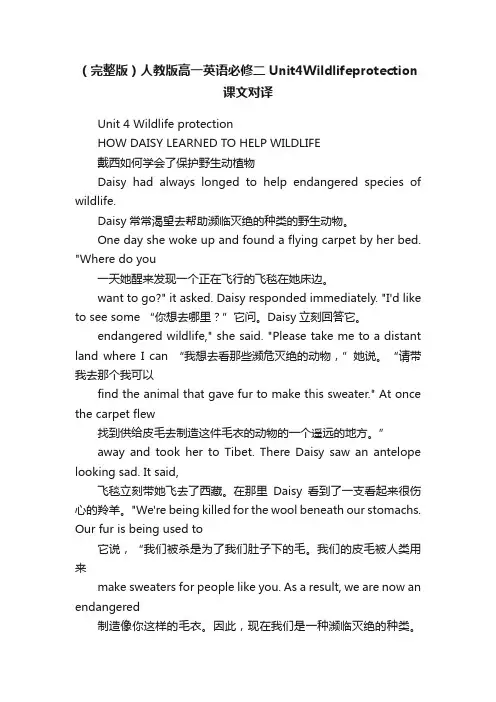
(完整版)人教版高一英语必修二Unit4Wildlifeprotection课文对译Unit 4 Wildlife protectionHOW DAISY LEARNED TO HELP WILDLIFE戴西如何学会了保护野生动植物Daisy had always longed to help endangered species of wildlife.Daisy常常渴望去帮助濒临灭绝的种类的野生动物。
One day she woke up and found a flying carpet by her bed. "Where do you一天她醒来发现一个正在飞行的飞毯在她床边。
want to go?" it asked. Daisy responded immediately. "I'd like to see some “你想去哪里?”它问。
Daisy立刻回答它。
endangered wildlife," she said. "Please take me to a distant land where I can “我想去看那些濒危灭绝的动物,”她说。
“请带我去那个我可以find the animal that gave fur to make this sweater." At once the carpet flew找到供给皮毛去制造这件毛衣的动物的一个遥远的地方。
”away and took her to Tibet. There Daisy saw an antelope looking sad. It said,飞毯立刻带她飞去了西藏。
在那里Daisy看到了一支看起来很伤心的羚羊。
"We're being killed for the wool beneath our stomachs. Our fur is being used to它说,“我们被杀是为了我们肚子下的毛。
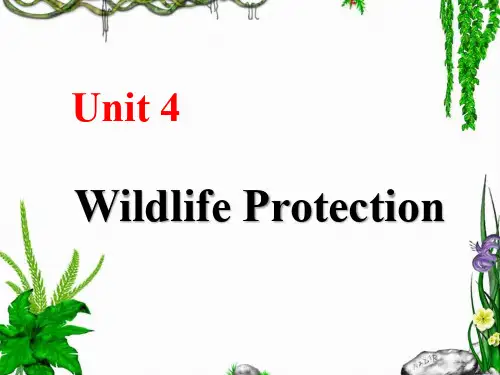
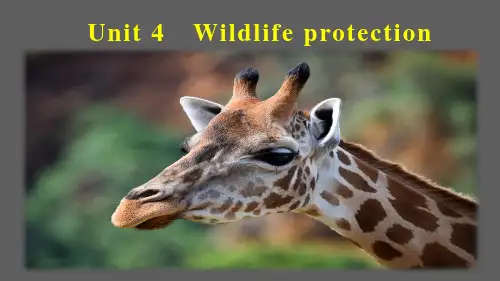
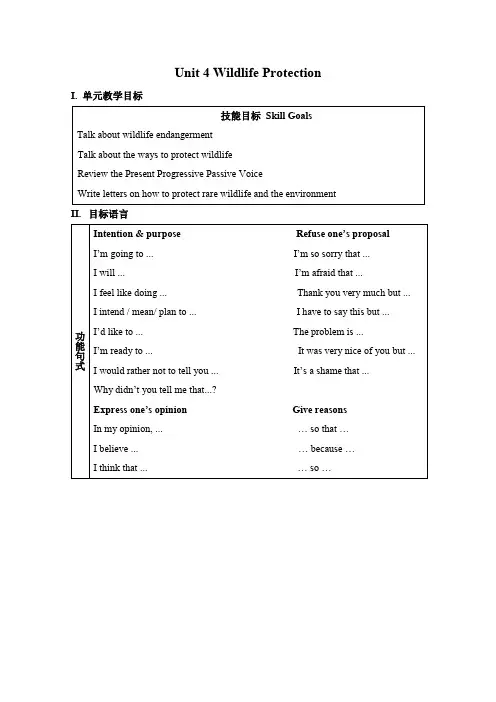
Unit 4 Wildlife Protection I. 单元教学目标II. 目标语言II. 教材分析与教材重组1. 教材分析本单元以保护动物为话题,旨在通过本单元的学习使学生了解很多动物已经灭绝或濒临灭绝,从而认识到保护动物的重要性和必要性;通过探讨保护动物的措施和建议,引导学生发表自己的见解和看法;通过进一步讨论提出有效的保护措施,唤起学生保护动植物、维护生态平衡、保护我们家园的责任感。
并能写信表达自己保护动物的方法与建议,力求正确表达自己的意图并解释原因,并能正确使用被动语态的现在进行时。
1.1 Warming Up首先帮助学生明确保护野生动物的原因以及方向。
旨在通过图片和表格引导学生讨论当今我国珍稀动物的现状。
以panda、Milu Deer、South China Tiger 为例,通过对这些珍惜动物所面临的问题、在中国的栖息地以及采取措施其后对比所做的报告,学生能够用已有的知识和经验讨论在中国处于保护状态下的濒临灭绝动物。
从而有效地引导学生关注本单元话题,关注动物生存现状。
1.2 Pre-reading是Reading的热身活动。
通过回答两个问题引导学生讨论自己所知道的濒临灭绝的动物并思考灭亡的原因。
同时要求学生通过阅读文中的图片和标题来猜测文章的内容。
1.3 Reading是一篇童话故事,讲述Daisy 乘坐飞毯跨越时空,在不同个国度、不同地区与生存状态不尽相同的和藏羚羊、大象、猴子对话的神奇经历,展示了Daisy逐渐认识保护动物重要性以及学习如何保护动物的经历。
动物们讲述了各自的处境,唤起了Daisy对动物的热爱以及保护动物的责任心。
从而号召人们热爱动物,保护动物,从我做起。
1.4 Comprehending考察学生对阅读内容的进一步理解与对所学知识的综合运用、迁移。
练习1要求学生根据阅读文的内容回答问题。
这四个问题设计到濒临物种生存现状,保护这些物种所取得成效的措施、保护动物栖息地的重要性以及决定保护成果能够的必要措施。
Unit 4 Wildlife protection本单元以环境保护为中心话题,内容涉及“野生动物保护”、“污染的防止”、“生活的环保”和“环保知识宣传”等。
语言知识和语言活动的设计是围绕“环境保护”这一中心话题展开的。
WARMING UP部分通过三图幅片导入本单元, 引出有关动物保护的话题并使学生了解濒危动物,树立保护动物、保护环境的意识。
LISTENING部分是有关“空气污染”、“水污染”和“环境污染”等的话题。
学生在听的过程中,要捕获信息,以提高听力的水平。
另外,教材还设计了讨论题作为“听后”活动,在形式上,把“听”与“说”相结合,力求训练学生的综合语言运用能力。
SPEAKING安排一组采访活动。
教材中提供了部分启发性的采访问题,帮助学生展开口语活动,同时还要求学生自己设计问题,发展自主能力。
活动具有趣味性,有助于学生亲近、关爱动物。
PRE-READING 部分以提问的形式导入课文,是阅读课文前的热身。
READING分三部分叙述主题内容。
1、人与动物的关系。
2、动物灭绝的原因。
3、补救措施。
文章语言简洁,条理清晰。
不仅有助于提高学生的阅读能力,而且在写作上也有所帮助。
POST-READING部分由两部分组成。
第一部分通过回答问题的形式,进一步加深对课文的理解。
第二部分围绕课文展开一些环保教育活动,要求学生列表说明每天要做的对环保有益的事,以培养学生的环保的责任感,调动他们参与环保行动的自觉性。
LANGUAGE STUDY部分分为词汇和语法两项。
词汇学习涉及构词法和词组填空练习。
帮助学生扩大词汇量,同时也指导学生掌握通过语境记忆词汇的方法。
本单元的语法项目是复习直接引语和间接引语。
INTEGRA TING SKILLS包括读写和写两部分。
第一部分体现了读是写的基础,写是读的发挥。
第二部分写作的任务是学会制作一张宣传环保的海报。
上述设计的目的是使学生能够边学边做,做到学用结合。
TIPS部分对怎样制作一幅成功的海报提出了一些建议,在语言方面具体指导学生完成制作海报的任务。